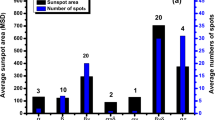Abstract
A method for determining the parameters of halo-type coronal mass ejections (full halo CMEs)—direction of motion, angular size, CME velocity along the Sun-Earth axis, etc.—has been proposed and tested. The method is based on the found empirical dependence between the angular sizes of CMEs located near the sky plane and angular sizes of associated eruptive prominences or post-eruptive arcades as well as on the relationships between the halo CME parameters derived in a simple geometrical CME model. Using this method and the SOHO/LASCO C3 and SOHO/EIT data, the parameters of 33 full halo CMEs have been determined. It is concluded that (1) the trajectories of all considered full halo CMEs deviate with recession of the CME front to R F > (2–5)R 0 toward the Sun-Earth axis; (2) the majority of full halo CMEs recorded by LASCO C3 coronagraphs have relatively large angular sizes, 2α > 60°.
Similar content being viewed by others
References
V. G. Eselevich and M. V. Eselevich, “Study of the Nonradial Directional Property of the Rays of the Streamer Belts and Chains in the Solar Corona,” Sol. Phys. 208, 5–16 (2002).
R. A. Harrison, E. Hildner, A. J. Hundhausen, et al., “The Launch of Solar Coronal Mass Ejections—Results from the Coronal Mass Ejection Onset Program,” J. Geophys. Res. 95, 917–937 (1990).
O. C. St. Cyr et al. “Properties of Coronal Mass Ejections: SOHO LASCO Observations from January 1996 to June 1998,” J. Geophys. Res. 105A, 18 169–18 185 (2000).
G. E. Brueckner et al., “The Large Angle Spectroscopic Coronagraph (LASCO),” Sol. Phys. 162, 357–402 (1995).
H. V. Cane and I. G. Richardson, “Interplanetary Coronal Mass Ejections in the Near-Earth Solar Wind during 1996–2002,” J. Geophys. Res. 108A, 1156 (2003).
H. V. Cane and I. G. Richardson, and O. C. St. Cyr, “Coronal Mass Ejections, Interplanetary Ejecta and Geomagnetic Storms,” Geophys. Res. Lett. 27, 3591 (2000).
N. B. Crosby, “Space Weather and Earth’s Climate,” in The Dynamic Sun, Ed. by A. Hanslmeier et al. (Kluwer Academic Publishers, 2001), pp. 95–128.
K. P. Dere et al., “EIT and LASCO Observations of the Initiation of a Coronal Mass Ejection,” Sol. Phys. 175, 601–612 (1997).
V. G. Eselevich, V. G. Fainshtein, and G. V. Rudenko, “Study of the Structure of Streamer Belts and Chains in the Solar Corona,” Sol. Phys. 188, 277–297 (1999).
N. Gopalswamy, A. Lara, S. Yashiro, et al., “Predicting the 1-AU Arrival Times of Coronal Mass Ejections,” J. Geophys. Res. 106, A12, 29 207–29 218 (2001).
R. A. Harrison and M. Lyons, “A Spectroscopic Study of Coronal Dimming Associated with a Coronal Mass Ejection,” Astron. Astrophys. 358, 1097–1108 (2000).
R. A. Howard, D. J. Michels, N. R. Sheeley, Jr., and M. J. Koomen, “The Observation of a Coronal Transients Directed at Earth,” Astrophys. J. 263, L101–L104 (1982).
H. S. Hudson and J. R. Lemon, O. C. St. Cyr, A. C. Sterling, and D. F. Webb, “X-Ray Coronal Changes during CMEs,” Geophys. Res. Lett. 244, L101, 1998.
A. J. Hundhausen, “Coronal Mass Ejections,” in Cosmic Winds and the Heliosphere, Ed. by J. R. Jokipii, C. P. Sonett, and M. S. Giampapa (University of Arizona Press, Tucson, 1997).
Y. Leblanc, G. A. Dulk, A. Vourlidas, and J.-L. Bougeret, “Tracing Shock Waves from the Corona to 1 AU: Type II Radio Emission and Relationship with CMEs,” J. Geophys. Res. 106, 25 301–25 312 (2001).
S. P. Plunkett, A. Vourlidas, S. Simberova, et al., “Simultaneous SOHO and Ground Based Observations a Large Eruptive Prominence and Coronal Mass Ejection:,” Sol. Phys. 194, 371–391 (2000).
N. R. Sheeley, Jr. J. H. Walters, Y.-M. Wang, and R. A. Howard, “Continuous Tracking of Coronal Outflows: Tow Kinds of Coronal Mass Ejections,” J. Geophys. Res. 104A, 24 739–24 767 (1999).
B. J. Thompson, O. C. St. Cyr, S. P. Plunkett, et al., “The Correspondence of EUV and White Light Observations of Coronal Mass Ejections with SOHO EIT and LASCO,” Geophys. Monogr. Am. Geophys. Union 109, 31–46 (1999).
Y. M. Wang, “Nonradial Coronal Streamers,” Appl. J 456, L119–L121 (1996).
Y. M. Wang, P. Z. Yee, S. Wang, et al., “A Statistical Study on the Geoeffectiveness of Earth-Directed Coronal Mass Ejections from March 1997 to December 2000,” J. Geophys. Res. 107A, 1340 (2002).
D. F. Webb, E. W. Cliver, N. U. Crooker, et al., “Relationship of HaloCoronal Mass Ejections, Magnetic Clouds, and Magnetic Storms,” J. Geophys. Res. 105, 7491 (2000).
X. P. Zhao and D. F. Webb, “Source Rejoins and Storm Effectiveness of Frontside Full Halo Coronal Mass Ejections,” J. Geophys. Res. 108, A6, SSH 4-1 Cite JD 1234 (2003).
C. Zhou, J. Wang, and Z. Cao, “Correlation between Halo Coronal Mass Ejections and Solar Surface Activity,” Astron. Astrophys. 397, 1057–1067 (2003).
Author information
Authors and Affiliations
Additional information
Original Russian Text © V.G. Fainshtein, 2006, published in Geomagnetizm i Aeronomiya, 2006, Vol. 46, No. 3, pp. 357–368.
Rights and permissions
About this article
Cite this article
Fainshtein, V.G. Method for determining the parameters of full halo coronal mass ejections. Geomagn. Aeron. 46, 339–349 (2006). https://doi.org/10.1134/S001679320603008X
Received:
Accepted:
Issue Date:
DOI: https://doi.org/10.1134/S001679320603008X




